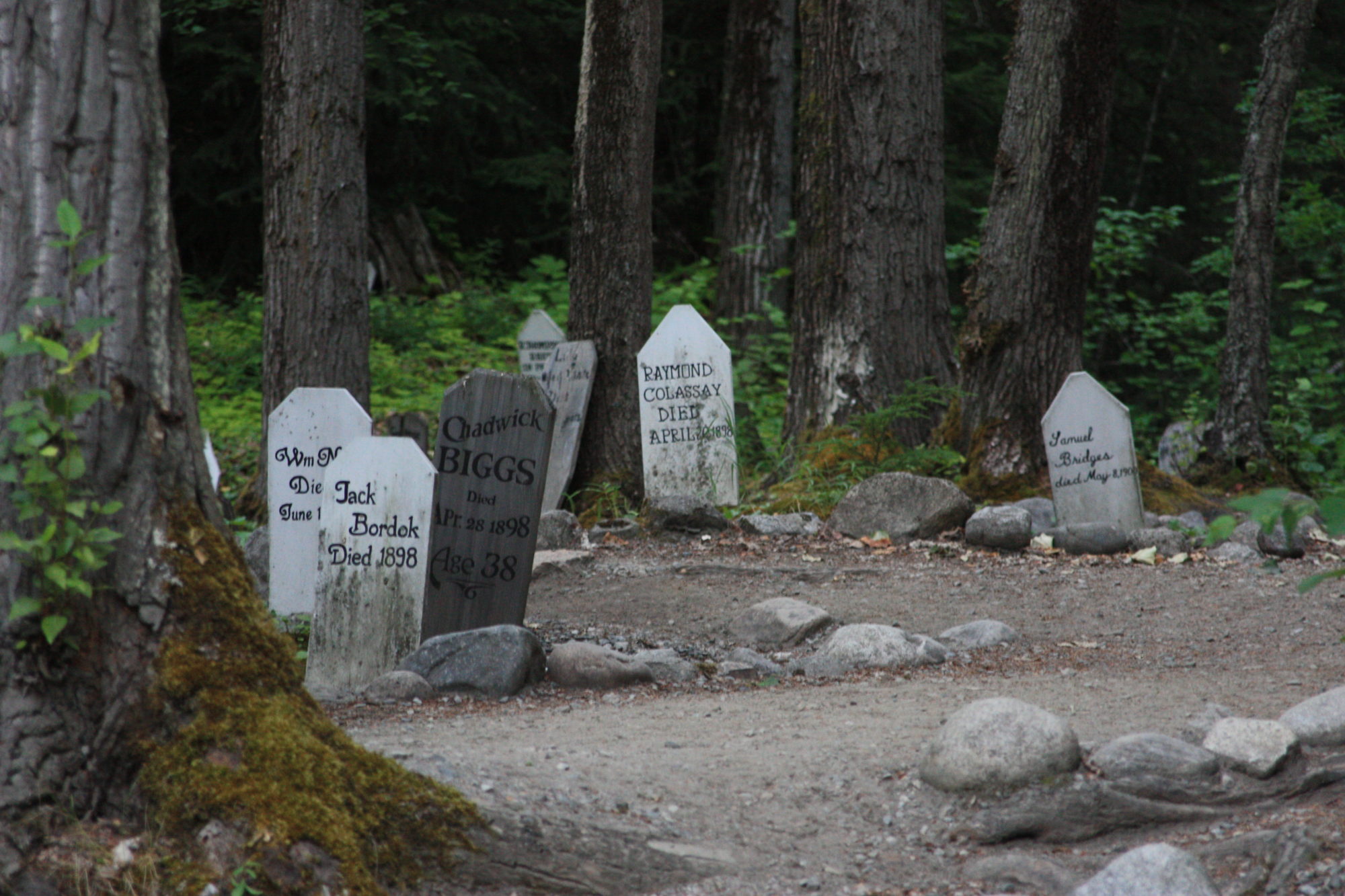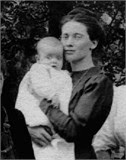This ad is from the Los Angeles Herald of February 1898. I wonder how many gold rushers wore one on the trail!
Adolf Frederick Fonzo
 Fred Fonzo was born in 1859 in Denmark. He married Mary Boyd in the San Francisco Bay area and had two children, Fred Jr. in 1892 in Berkeley and Myrtle. He ran the Acheson Hotel and also worked as a constable in Berkeley.
Fred Fonzo was born in 1859 in Denmark. He married Mary Boyd in the San Francisco Bay area and had two children, Fred Jr. in 1892 in Berkeley and Myrtle. He ran the Acheson Hotel and also worked as a constable in Berkeley.
In 1894 his wife died and so he headed north to Alaska. He apparently never bothered to write to the family to let them know where he was. They assumed that he had died, but he appeared in Skagway about 1909 where he worked as the U.S. Jailer and Marshal. On June 16, 1911, while trying to evict Miss Mary Bernhofer from the New Home Hotel, her niece, Lena Bernhofer, aged 16, shot Marshal Fonzo. The bullet pierced his arm and lodged in his chest but did not kill him. However, news of the bullet reached the Oakland Tribune on June 22, 1911 and the family discovered his whereabouts (having mourned him for 17 years).
Meanwhile Mary Bernhofer refused to leave the hotel and said she would burn it down and kill herself if evicted. Mary Bernhofer was the hotel proprietor of the “New Home Restaurant & Lodging house” since 1897. In 1915 she appeared in Juneau as a housekeeper at The Bergman Hotel, but her employer died the next year and so Mary Bernhofer became the manager for many years. This hotel, on 3rd downtown, now a hostel, is still running today, seen above.
Fred Fonzo died on this day, June 4, 1927 in Seattle at the age of 68.
Rebecca Schuldenfrei
There is a wonderful story about Rebecca and Solomon Schuldenfrei. Their great great granddaughter tells it best and you can read it in its entirety by following the link below.
“Rebecca Schuldenfrei was born in 1863 near Krakow in the Austro-Hungarian empire. At a young age she immigrated to America and lived most of her life in New York. In 1897 her husband, Solomon decided to set out to the Klondike with a business partner in search of gold. As the trip rapidly approached, the partner decided he could not leave his business and backed out. Becci, concerned that her husband was not tough enough for the wilds of the Yukon, would not let him go off alone and decided to come along. The couple had three children and, in a move very uncommon to mothers of her day, Rebecca left them in the care of her sister and joined her husband as a partner on his adventure. Having never lived outside a city, both Sol and Becci had no way of knowing what kind of dangers they faced. They went for practical reasons: Sol’s business had not been very successful, but they must have had some sense of adventure or else they would not have taken all the risks they did. Most of what is known about Rebecca Schuldenfrei comes from the numerous letters she wrote to her sister and her children during the entire trip. Where these letters are quoted, her spelling and grammar is used. Whether what she says is completely accurate or whether it was appropriately filtered for her readers is unknown. What the letters definitely show is an incredible journey of a urban woman in the wilderness of the Yukon.
All the knowledge Becci and Sol could have had of the Yukon was gained from newspapers and stories. They brought what they guessed they would need, but they had no sure way of telling. They were outfitted by a company known as Cooper & Levy. Mrs. Cooper, wife of one of the owners, came out to the shop to see “the lady who goes to Klondike in a silk skirt” (Sept. 5, 1897). Becci was gaining a reputation. Sol had to be talked into buying a gun as the couple knew nothing about handling weapons. They had to buy a year’s worth of supplies which would end up costing them hundreds of dollars to transport. However, due to the enormous inflation in the Klondike, the more supplies one brought, the better.”
The one curious fact that I had from a different source was that Sol paid the Indian guides $700 to pack their canoe with Rebecca inside of it, over the Chilkoot Pass. What a guy!!!
“Having practically no money when they arrived, Becci decided to open a restaurant for a few months until her husband could get a claim. On October 19, Becci wrote, “Just at present things do not look so bright here as they are pictured in the newspapers…this beautiful Klondike is only good for very strong and hardworking miners, as any one, who is not brought up from childhood to the hardest kind of labor, is of no earthly use here.”
They are pictured above.
http://www.s-i-inc.com/women2.htm
Judge Frederick McBain Young
Frederick McBain Young was born in October 1863 or 1868 in Montreal. He graduated with a B.A. from Queen’s University and made his way to Nanaimo where he married in 1893. In 1895 he was made a Barrister in Nanaimo. During the gold rush he came north and was in Skagway briefly. He was a friend of John Douglas Stewart who was famously robbed by three of Soapy’s gang members in 1898. Stewart was also from Nanaimo. Young was the first judge of the county court of Atlin, B.C. in 1905. He served 28 years as judge in Prince Rupert county court from 1907. He retired and returned to Vancouver in January 1933, and died in Vancouver on May 31, 1937. Seen above is the Atlin courthouse built in 1900 which Judge Young used.
Skagaway?
Frederick Washington Harte
Fred Harte was born in 1839 in Northern Ireland and came to the Yukon in 1873. His party, with Arthur Harper, George Finch and Kinseller reached Fort Yukon from Canada by way of the Mackenzie, Peel, and Porcupine Rivers through the Chilkoot Pass in 1873. This well documented party is perhaps the first white party to cross the Chilkoot Pass. Harte later worked with McQueston and Mayo. All of these men were trappers who searched for furs but were at the beginning of the mining era when gold was discovered in the Yukon. All of these famous early explorers can have their own story told, but here we are celebrating Fred Hart. He was one of the charter member of the Yukon Order of Pioneers and served as the first Secretary for the Y.O.O.P. He died in November 1898 and is buried in the Pioneer Cemetery in Dawson. Seen above are some members holding the banner in Dawson.
Jack Hoyt
Jack was born in 1904 in Oregon and came to Skagway around 1929 and worked for White Pass as a boilermaker. He was Mayor of Skagway during World War two. If you have ever visited Oahu, Hawaii and gone to the Dole plantation which is about half way between Honolulu and North Shore, they have a very cute tourist train called the Pineapple Express. It has rails about 24 inches apart. Jack Hoyt built this little tourist railroad in 1969. I don’t know how much of the original train that he built is still running, but it is a favorite tourist attraction still.
Winfield Scott Woolever
W.S. Woolever was born on this day, May 17, 1863. Before heading out for the gold rush, he was a partner in a hardware store in Wallaceburg, Ontario, Canada. He caught gold fever and abandoned his wife Clara (Ayres) and his two daughters, Miriam and Yula. The daughters had a brief reunion with him some years later in Seattle at which time, he gave my grandmother Miriam his gold rush journal. For those interested in his journal is presently at the Wallaceburg museum.
Between 1901 and 1904 Woolever staked gold claims in the Yukon and actually came away with some profits. During his time here in Skagway, he became an active member of the Arctic Brotherhood. Woolever married Paulina Scott Banks after 1905. When Paulina died in 1927 Woolever met Daisy Banks Haner, also a widow in 1926. They married on August 01, 1927 in Whatcom Co., WA.
Winfield Scott Woolever died on May 4, 1945 in Wickersham, Washington at the age of 82. Seen above is his third wife, Daisy with her son Lawrence Haner, born 1912, and taken at their Wickersham, Washington home.
Paulina was not the sister of Robert Bruce Banks who died in the fiery explosion of the Clara Nevada here in Skagway in 1898.
Many thanks to John Martin for the early history in Ontario, and to Beverly Banks Hammer and Malcolm Haner, grandson of Daisy for setting this story correct! As with all family histories, the true stories lie with the family, not all of which are as stalwart as we would hope. I just try to spotlight the goldrushers for their feats here in Skagway and the Klondike!
The Telegraph Line
I have often wondered about the telegraph lines seen along the road in various places with the glass insulators. In 1898-99 when the narrow-gauge White Pass & Yukon Route Railway was built, from Skagway through the White Pass to Bennett City near the BC-Yukon border, they also put in the telegraph line. Before construction was completed in July 1899, the Canadian Privy Council approved the extension of the telegraph line to Dawson City and a spur line to Atlin, British Columbia, where a gold strike had occurred the previous year. Construction on the 1,000-kilometre Yukon portion of the Yukon Telegraph line began at Bennett Lake and finished in Dawson City in September 1899 ahead of schedule. Twenty-eight men, four of whom drowned in the Yukon River, completed the work in six months, traveling by waterway and stringing wire at a rate of 10 to 16 kilometres a day. The estimated cost for the project was $135,750. Supplies arrived in Skagway from as far away as Great Britain, including 600 miles of No. 8 (5mm) wire, hundreds of boxes of insulators and side blocks, and provisions for a 100-man workforce. John Franklin Richardson, construction superintendent worked for John Baptiste Charleson the supervisor of construction. J.C. Tache was the chief engineer (seen above in Skagway) and Joseph Gobeil was the private secretary. Even Michael J. Heney helped by supplying pack horses to bring the supplies to the pass. There are lots more really intereting stories about this in the following book: Wires in the Wilderness: The Story of the Yukon Telegraph by Bill Miller
Edward J. Shaw
Edward J. Shaw was born in 1859 in Massachusetts. He arrived in Skagway early in the century and first worked on Moore’s Wharf and as a bookkeeper. He also worked as a gardener and for the Alaska Steamship Company as an agent. He was a member of the Arctic Brotherhood and was on City Council from 1903-1906. He was a U.S. Commissioner in 1906 as seen above, he is the one standing to the far right. By 1906 he served as Skagway Mayor and as City Manager. By 1920 he was married to Marian, but I could find no record of them after the 1920 census.
1905, 1915,1920.1909 AB book, agent for Ak SS Co ; Barley photo; Thornton








